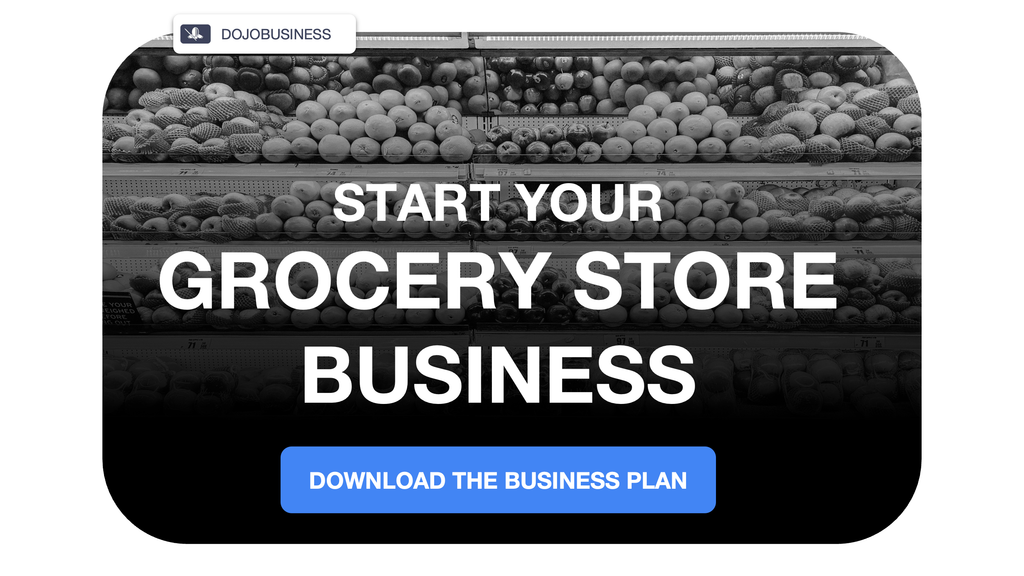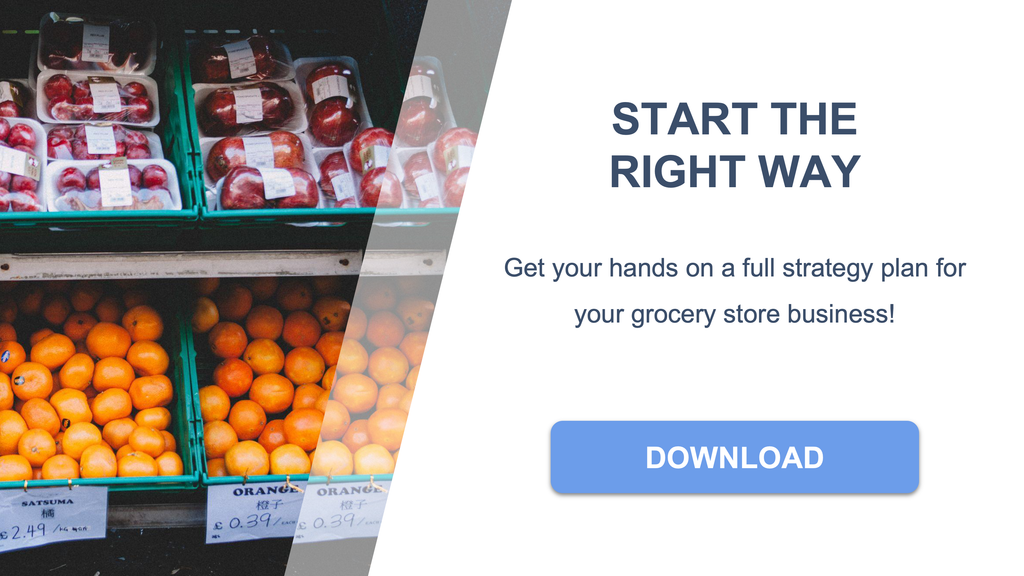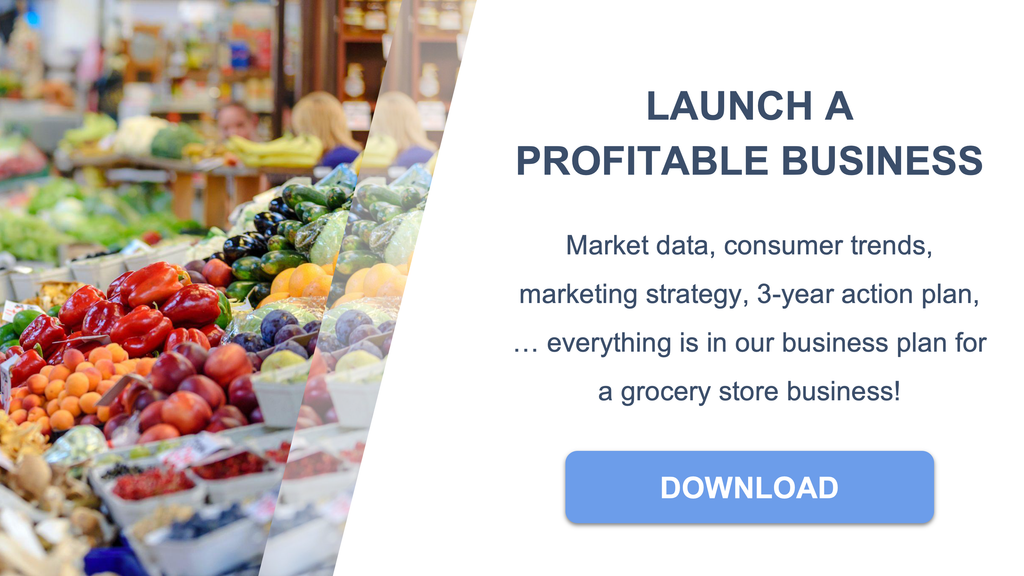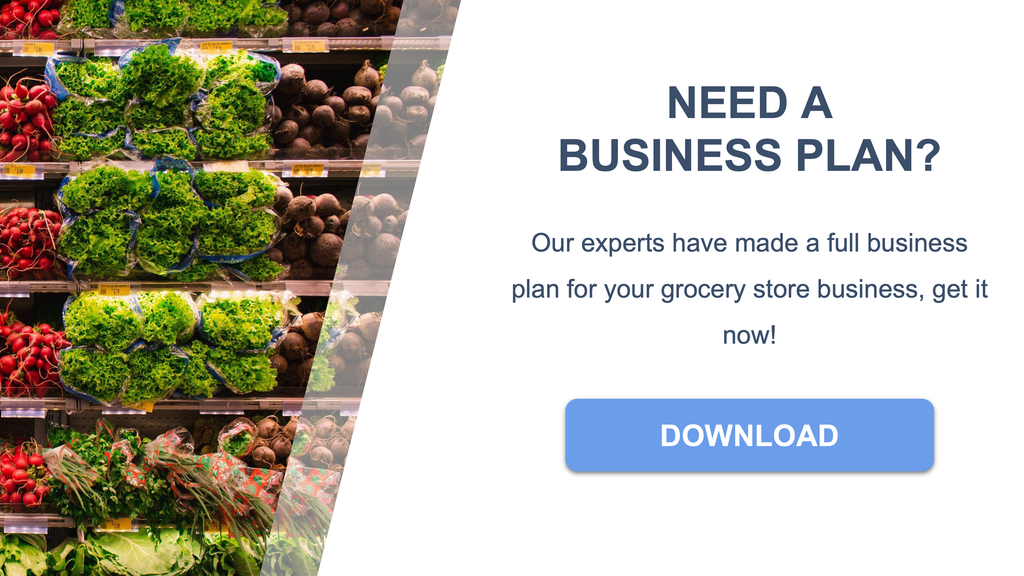This article was written by our expert who is surveying the industry and constantly updating the business plan for a grocery store.

Our business plan for a grocery store will help you build a profitable project
Understanding your grocery store's break-even point is the difference between launching blindly and building a business that actually makes money.
Before you sign a lease or stock your first shelf, you need to know exactly how many customers you need, what margins you'll earn, and when your store will stop losing money and start generating profit. This article breaks down every financial metric that determines whether your grocery store survives or fails in the competitive retail landscape of 2025.
If you want to dig deeper and learn more, you can download our business plan for a grocery store. Also, before launching, get all the profit, revenue, and cost breakdowns you need for complete clarity with our grocery store financial forecast.
A mid-sized grocery store needs to generate between $185,000 and $240,000 in monthly revenue to cover all fixed and variable costs and reach break-even.
Most grocery stores achieve this milestone within 12 to 16 months under moderate market conditions, though strong locations can break even in as little as 7 months while challenging markets may take up to 24 months.
| Financial Metric | Conservative Scenario | Optimistic Scenario |
|---|---|---|
| Monthly Sales Volume | 20,000–25,000 units | 40,000–50,000 units |
| Monthly Revenue | $175,000–$200,000 | $320,000–$370,000 |
| Fixed Monthly Costs | $13,500–$20,000 (rent, salaries, utilities, insurance) | $18,000–$34,000 (larger store, more staff) |
| Gross Margin | 22–24% overall margin | 25–27% overall margin |
| Break-Even Monthly Revenue | $185,000–$210,000 | $220,000–$240,000 |
| Initial Investment Required | $142,000–$215,000 (lease, fixtures, inventory, systems) | $200,000–$390,000 (premium location, larger store) |
| Time to Break-Even | 18–24 months (slow ramp-up) | 7–10 months (strong launch, good location) |
| Monthly Shrinkage Loss | $2,625–$4,000 (1.5% of sales) | $9,600–$11,100 (3% of sales in high-volume stores) |

What monthly sales volume and revenue should a grocery store realistically expect?
A mid-sized grocery store in 2025 can expect monthly sales volumes between 20,000 and 50,000 units, generating total revenue of $175,000 to $370,000 depending on location, product mix, and store size.
The lower end of this range applies to grocery stores in suburban or rural areas with moderate foot traffic, while urban stores in high-density neighborhoods with strong customer flow hit the upper range. Your actual sales volume depends heavily on your store's square footage, product assortment, and how well you convert walk-ins into paying customers.
Average basket size in grocery stores ranges from $25 to $37.50 per transaction, with customers purchasing between 7 and 15 items per visit. Stores that focus on fresh produce, prepared meals, and premium products tend to achieve higher basket sizes, while discount-focused stores see higher transaction volumes but lower per-customer spending.
Daily foot traffic for a typical grocery store ranges from 150 to 450 customers, and with conversion rates between 85% and 95%—groceries are necessity purchases, so most people who walk in actually buy something. This means you can expect 130 to 430 completed transactions per day, translating to roughly 3,900 to 12,900 transactions monthly.
You'll find detailed market insights in our grocery store business plan, updated every quarter.
How stable are grocery prices across different product categories in 2025?
Grocery pricing in 2025 shows overall stability with inflation rates of 1–3% across most categories, though certain products like eggs, beef, and beverages face significantly higher volatility due to tariffs and supply chain disruptions.
| Product Category | Average Selling Price | Price Stability | Key Volatility Factors |
|---|---|---|---|
| Dairy | $2–$4 per unit | Stable (1–2% inflation) | Milk and cheese prices holding steady with minimal seasonal variation |
| Meat & Poultry | $4–$9 per unit | Moderate volatility (up to 8% inflation) | Beef prices affected by tariffs and feed costs; chicken more stable |
| Produce | $1–$3 per unit | Slightly deflationary | Seasonal harvests and improved supply chains reducing prices in 2025 |
| Bakery & Snacks | $2–$4 per unit | Stable (1–3% inflation) | Packaged goods with consistent pricing due to long-term supplier contracts |
| Beverages | $1–$6 per unit | High volatility (up to 25% swings) | Coffee and tea prices fluctuating due to international tariffs and weather events |
| Eggs | $3–$5 per dozen | Extremely volatile (up 40% in 2025) | Avian flu outbreaks and production disruptions causing sharp price increases |
| Packaged Goods | $2–$8 per unit | Very stable (under 2% inflation) | Center-store items with predictable pricing and minimal supplier changes |
The most unpredictable categories—eggs, beef, and specialty beverages—require weekly price monitoring and flexible sourcing strategies to protect your margins and avoid shocking your customers with sudden price jumps.
What are the fixed monthly operating costs for running a grocery store?
Fixed monthly operating costs for a grocery store typically range from $13,500 to $34,000, covering rent, utilities, salaries, insurance, and licensing fees that you must pay regardless of sales volume.
Rent and utilities represent 15–20% of your monthly operating costs, ranging from $3,000 in suburban locations to $12,000 in high-traffic urban areas. Store size, local real estate prices, and energy efficiency directly impact this expense—larger stores with extensive refrigeration systems pay significantly more for electricity and climate control.
Salaries and wages consume 25–30% of monthly costs, typically $9,000 to $18,000 for a mid-sized store with a small management team and hourly staff. This includes cashiers, stock clerks, department managers, and administrative personnel, with actual costs varying based on local minimum wage laws and your staffing model.
Insurance and licensing fees account for 5–10% of monthly costs, ranging from $1,500 to $4,000. This covers general liability insurance, property insurance, workers' compensation, food handling permits, business licenses, and health department certifications required to operate legally.
This is one of the strategies explained in our grocery store business plan.
What variable costs should you expect per unit sold in a grocery store?
Variable costs per unit sold in a grocery store include wholesale purchase prices (60–70% of retail), packaging costs ($0.10–$0.25 per unit for perishables), and transaction fees ($0.05–$0.15 per unit for card and digital payments).
The wholesale purchase price is your largest variable cost—you're paying suppliers between 60 cents and 70 cents for every dollar you charge customers. This ratio varies by product category, with fresh produce and meat typically at the higher end (70% cost) while packaged goods offer better margins (closer to 60% cost).
Packaging costs apply primarily to perishable goods like deli items, fresh-cut produce, and bakery products that require containers, wrapping, or labeling. These costs add $0.10 to $0.25 per unit and directly reduce your gross margin on fresh departments, though these categories often command premium pricing that offsets packaging expenses.
Transaction fees from credit card processors, mobile payment systems, and digital wallets cost $0.05 to $0.15 per transaction, depending on payment method and your processor's rates. As cashless payments dominate grocery shopping in 2025, these fees represent an unavoidable variable cost that increases proportionally with sales volume.
What gross margin can you expect per unit and by product category?
Grocery stores operate on an overall gross margin of 22–27%, with significant variation between product categories—center-store packaged goods earn just 1–3% margins while perimeter departments like deli, bakery, and fresh produce achieve 20–40% margins.
| Product Category | Gross Margin Range | Margin Characteristics |
|---|---|---|
| Packaged Center-Store Goods | 1–3% | Highly competitive category with thin margins due to brand competition and price transparency; volume-driven profitability |
| Fresh Produce | 20–30% | Higher margins offset by shrinkage from spoilage; organic and specialty produce commands premium pricing |
| Meat & Seafood | 18–28% | Skilled butchery and preparation justify higher margins; premium cuts and prepared items at upper end |
| Deli & Prepared Foods | 30–40% | Highest margin category due to value-added preparation and convenience premium; hot food programs especially profitable |
| Bakery | 25–35% | In-store baked goods command strong margins; pre-packaged bakery items closer to 15–20% |
| Dairy & Refrigerated | 15–22% | Moderate margins with consistent demand; specialty dairy and plant-based alternatives at higher end |
| Beverages | 12–20% | Soft drinks and bottled water at lower end; craft beverages and specialty drinks at upper range |
| Frozen Foods | 10–18% | Moderate margins with low shrinkage; premium frozen meals and specialty items achieve higher margins |
Your overall store margin depends on your product mix—stores emphasizing high-margin perimeter departments (deli, bakery, fresh) achieve 25–27% overall margins, while discount-focused stores with heavy center-store volume operate closer to 22–24% margins.
How much initial investment does opening a grocery store require?
Opening a grocery store requires an initial investment between $142,000 and $390,000, covering lease deposits, store fixtures and equipment, initial inventory, point-of-sale systems, working capital, and launch marketing.
Lease deposits and build-out costs range from $5,000 to $20,000 depending on your location and landlord requirements. Urban locations with high foot traffic demand premium deposits, while suburban strip mall locations offer more affordable entry points but potentially lower customer volume.
Store fixtures and refrigeration equipment represent your largest capital expense at $35,000 to $100,000. This includes shelving systems, refrigerated display cases, freezer units, checkout counters, shopping carts, and storage equipment—all essential infrastructure that determines your store's capacity and operational efficiency.
Initial inventory to stock your store costs $50,000 to $125,000, covering the product assortment needed to open your doors. Larger stores with broader product selections and extensive fresh departments require inventory at the upper end of this range, while smaller format stores can launch with more modest stock levels.
Point-of-sale systems, inventory management software, and IT infrastructure cost $20,000 to $50,000 for modern integrated systems that handle transactions, track inventory, manage pricing, and generate sales analytics. This technology investment is non-negotiable in 2025—you cannot compete without real-time inventory visibility and customer data.
Working capital of $25,000 to $75,000 provides the cash buffer needed to cover operating expenses during your first one to two months before revenue stabilizes. This ensures you can pay suppliers, staff, and utilities while building your customer base without running out of cash.
We cover this exact topic in the grocery store business plan.
What customer foot traffic and conversion rates should a grocery store expect?
A typical grocery store experiences daily foot traffic of 150 to 450 customers, with conversion rates between 85% and 95%—significantly higher than most retail categories because groceries are necessity purchases rather than discretionary shopping.
Foot traffic varies dramatically by location and day of week. Urban grocery stores in residential neighborhoods see consistent weekday traffic as customers shop for immediate needs, while suburban stores experience weekend spikes when families do weekly shopping trips. Stores near public transportation or in mixed-use developments benefit from higher walk-in traffic throughout the week.
The 85–95% conversion rate means that almost everyone who enters your store completes a purchase. Unlike apparel or electronics retail where browsing is common, grocery shoppers arrive with specific needs and rarely leave empty-handed, making foot traffic the most reliable predictor of sales volume.
Average basket size—the number of items per transaction—ranges from 7 to 15 units depending on your store format. Quick-stop urban markets average 7–10 items per trip as customers grab immediate needs, while larger suburban grocery stores see 12–15 items per basket as customers stock up for the week.
Customer spending per transaction ranges from $25 to $37.50, translating to roughly $3 to $3.50 per unit purchased. Stores with strong fresh departments, prepared foods, and premium products push basket values toward the upper end, while discount-focused stores see higher transaction counts but lower per-customer spending.
What should you budget for marketing and what sales increase can you expect?
Grocery stores should allocate 3–5% of monthly revenue to marketing and promotions, translating to $5,250 to $18,500 per month for stores generating $175,000 to $370,000 in sales.
This marketing budget covers grand opening promotions, weekly circular advertising, digital marketing campaigns, loyalty program incentives, in-store signage, and seasonal promotional events. The exact allocation depends on your competitive environment—stores facing intense competition from established chains need to invest at the upper end to attract customers away from familiar alternatives.
Realistic sales uplift from well-executed marketing campaigns ranges from 5% to 12% increase in foot traffic and transaction volume. The most effective strategies combine digital advertising targeting local residents, loyalty programs that encourage repeat visits, and strategic loss-leader pricing on high-visibility items that drive store traffic.
New grocery stores benefit most from launch marketing that builds initial awareness and trial purchases, while mature stores use ongoing marketing to maintain customer frequency and combat competitive threats. Grand opening campaigns with significant promotional spending can generate 15–20% traffic spikes, though sustained growth requires consistent marketing investment rather than one-time splurges.
The return on marketing investment in grocery retail typically shows up as increased basket frequency (customers shopping more often) rather than dramatically higher basket sizes, since grocery spending per trip remains relatively stable and limited by household needs.
What shrinkage rate from spoilage, theft, and waste should you plan for?
Grocery stores experience shrinkage rates of 1.5–3% of total sales monthly, resulting in losses between $2,625 and $11,100 for stores generating $175,000 to $370,000 in revenue.
Shrinkage in grocery stores comes from three primary sources: product spoilage (especially in fresh departments), theft (both customer shoplifting and employee theft), and operational waste (damaged goods, expired products, administrative errors). Fresh departments like produce, meat, and bakery account for the majority of shrinkage due to limited shelf life and quality degradation.
The 1.5% shrinkage rate represents best-in-class operations with strong inventory controls, effective fresh department management, proper rotation practices, and security measures. Stores at the 3% shrinkage level typically struggle with one or more areas—poor inventory tracking, inadequate refrigeration, lax security, or insufficient staff training on product handling.
Controlling shrinkage requires systematic approaches across all departments. This includes first-in-first-out rotation protocols, daily temperature monitoring for refrigerated cases, security cameras in high-theft areas, regular inventory audits, and staff training on product handling and waste reduction techniques.
The financial impact of shrinkage directly reduces your net profit. A store with 25% gross margin and 2% shrinkage effectively loses 8% of its gross profit to waste and theft—making shrinkage control one of the most impactful operational priorities for maintaining profitability.
It's a key part of what we outline in the grocery store business plan.
What is the actual break-even point—the minimum monthly sales needed to cover all costs?
The break-even point for a grocery store is 22,000 to 28,000 units sold monthly, generating $185,000 to $240,000 in revenue—the minimum needed to cover all fixed and variable costs before earning any profit.
This break-even calculation assumes a gross margin of 22–27%, which represents the industry standard for grocery retail in 2025. Stores operating at the lower margin (22–24%) due to competitive pricing or discount positioning need higher sales volume to break even, while stores achieving 25–27% margins through strong fresh departments and premium positioning break even at lower volumes.
Your specific break-even point depends on your fixed cost structure. Stores with high rent in premium locations or extensive staffing require higher revenue to cover fixed costs, while lean operations in affordable locations break even at lower sales thresholds. A store with $20,000 in monthly fixed costs and 24% gross margin needs $83,333 in sales just to cover fixed expenses, then additional sales to cover variable costs.
The calculation works like this: if your total fixed costs are $18,000 monthly and your gross margin is 25%, you need $72,000 in sales to cover fixed costs ($18,000 ÷ 0.25 = $72,000). Then you need additional sales to cover variable costs and shrinkage, pushing total break-even to approximately $185,000–$210,000 depending on your specific cost structure.
Breaking even means generating enough revenue to cover rent, utilities, salaries, insurance, wholesale product costs, transaction fees, shrinkage, and all other operating expenses—with zero profit. Any sales above break-even convert directly to net profit at your gross margin rate, making every dollar of sales above break-even significantly more valuable than the dollars that simply cover costs.
How long does it take to reach break-even under different scenarios?
Grocery stores reach break-even in 7 to 24 months depending on location quality, competitive intensity, and execution strength—with most stores achieving break-even within 12 to 16 months under moderate conditions.
| Scenario | Time to Break-Even | Characteristics | Key Success Factors |
|---|---|---|---|
| Optimistic | 7–10 months | Strong location with high foot traffic, limited competition, effective grand opening, rapid customer adoption | Premium location near residential density; experienced management team; strong launch marketing; differentiated product mix |
| Moderate | 12–16 months | Good location with reasonable traffic, moderate competition, solid execution, steady customer base growth | Competitive location; adequate parking; balanced product assortment; consistent marketing; good operational controls |
| Conservative | 18–24 months | Challenging location, intense competition from established players, slow market penetration, extended ramp-up period | Lower-traffic location; need to build awareness; price-competitive market; lean operations required to survive ramp-up |
| Difficult | 24+ months or never | Poor location selection, overwhelming competition, operational problems, insufficient capital, weak differentiation | Fundamental market or execution problems; may require strategic pivot or closure; not all stores reach break-even |
The path to break-even follows a predictable pattern: months 1–3 show the lowest sales as you build awareness and trial, months 4–8 show steady growth as repeat customers establish shopping patterns, and months 9–16 show stabilization as your store reaches its natural customer base and sustainable sales volume.
Stores that break even faster typically benefit from one or more advantages: high-visibility locations that generate walk-in traffic, underserved markets with limited competition, strong launch marketing that accelerates awareness, or experienced operators who avoid costly startup mistakes that delay profitability.
Stores that take longer to break even usually face structural challenges: intense competition from established chains with customer loyalty, locations requiring aggressive marketing to drive awareness, operational inefficiencies that erode margins, or undercapitalization that limits marketing investment and forces reactive rather than strategic decision-making.
What external risks could significantly delay or prevent reaching break-even?
- Supplier price increases and tariff shocks: Sudden increases in wholesale costs from suppliers—particularly for high-volume categories like meat, eggs, coffee, and aluminum-packaged beverages—compress your gross margins and force you to either raise prices (risking customer loss) or absorb costs (delaying break-even). The 40% spike in egg prices and 25% volatility in coffee costs during 2025 demonstrate how quickly supplier disruptions can impact your profitability.
- Competitive market entry: New competitors entering your market—whether discount chains, online grocery services, or specialty stores—can capture market share before you establish a loyal customer base. This is especially damaging during your first year when you're building awareness and trying to convert trial shoppers into repeat customers.
- Shifts in consumer demand patterns: Economic downturns that reduce discretionary food spending, demographic changes in your trade area, or shifts toward online grocery delivery can all reduce foot traffic and average basket size. The rapid growth of e-grocery services in 2025 shows how quickly consumer preferences can change, potentially leaving traditional stores with lower transaction volumes.
- Labor market tightness and wage inflation: Difficulty hiring and retaining staff, or unexpected minimum wage increases, drive up your fixed labor costs and reduce the margin available to cover other expenses. This is particularly challenging during the ramp-up period when sales haven't stabilized but you need full staffing to serve customers effectively.
- Regulatory and compliance changes: New food safety regulations, licensing requirements, or health department mandates can impose unexpected costs for equipment upgrades, certifications, or operational changes. These unplanned expenses drain working capital and delay profitability, especially for undercapitalized operators.
- Real estate and occupancy issues: Rent increases upon lease renewal, property tax reassessments, utility rate hikes, or unexpected facility maintenance costs can significantly increase your fixed cost base. A 15–20% rent increase can push break-even revenue up by $30,000–$50,000 monthly, requiring substantial sales growth just to maintain the same profitability trajectory.
- Technology and system failures: Point-of-sale system outages, inventory management software problems, or payment processing failures disrupt operations and create customer dissatisfaction. These incidents not only cost immediate sales but damage your reputation during the critical early months when you're trying to build a loyal customer base.
Conclusion
This article is for informational purposes only and should not be considered financial advice. Readers are encouraged to consult with a qualified professional before making any investment decisions. We accept no liability for any actions taken based on the information provided.
Opening a grocery store requires understanding every financial detail from day one.
The difference between success and failure often comes down to accurate projections and realistic planning. Our comprehensive business plan gives you the detailed financial models, market analysis, and operational frameworks you need to launch profitably and reach break-even on schedule. Don't guess—plan with precision using data-backed projections and proven strategies from successful grocery store operators.
Sources
- Food Industry Association - Food Industry Facts
- USDA Economic Research Service - Food Price Outlook
- Retail Today - Price Hikes Vary Across Categories
- Dojo Business - Grocery Store Break-Even Point
- Business Plan Templates - Grocery Store Running Costs
- CSI Market - Grocery Stores Profitability Ratios
- Placer.ai - Grocery in 2025: Visitation Trends and Consumer Behavior
- Business Plan Templates - Grocery Store Startup Costs
- CNBC - Food Costs Remain High and Could Rise Further with Tariffs
- FoodStorm - Grocery Perimeter Department ROI
- How to Write a Business Plan for a Grocery Store
- How Much Does It Cost to Open a Grocery Store?
- Is Opening a Grocery Store Profitable?
- What Budget for Utilities in a Grocery Store?
- How Many Shoppers Does a Grocery Store Need to Break Even?
- What Should Customers Spend in Your Grocery Store?
- What Initial Inventory Does a Grocery Store Need?






